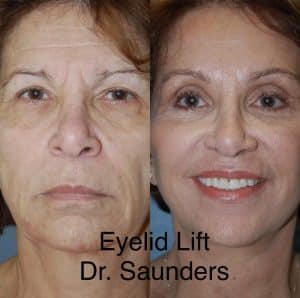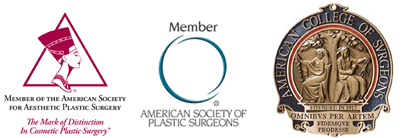It is important to understand how the blepharoplasty or eyelid tuck is technically done, if you are considering this cosmetic operation. This educational writing is designed to help you learn about all the important elements that go into the technical aspects of the operation. By understanding how the operation is actually performed, you will have a better understanding of some of the essential aspects of the eyelid lift. This educational writing was done at the request of a patient of mine from Philadelphia, PA.
A: Overview
A blepharoplasty is an operation to help improve the appearance of the eyelid area. As we age, we develop hooding, bags, and circles around the eyes. The operation is done to reverse these age associated changes. By doing the procedure, we become more refreshed and youthful in the eye area. You can watch me perform an eye tuck operation by clicking on this link. It’s a very cool video that most find interesting, and it’s very delicate and precise.
B: Upper Eyelid Lift or Eye Tuck
Upper eyelid surgery is typically done for excess skin and fullness in the upper eyelids. The excess skin is called hooding, and the medical term is dermatochalsis. The eye lift is done with an incision in the eyelid crease. This is the line above your upper eye lashes, and it is located about 6-12 mm above the lashes. It also is called the supratarsal crease. The excess skin that occurs with aging often covers and hides the eyelid crease. So when woman wear make-up, the crease can be covered or blurred, and eye shadow doesn’t work and smudges. The incision for the eye tuck is typically placed right in this crease. By placing it right in this crease or location, we know we will usually have extremely good fading of the incision as part of the result.
B1: Technique
The operative technique I use addresses all 3 important layers including the skin, muscle, and fat. I believe this is the most advanced way to perform this operation. Some doctors just remove the excess skin during their eye tuck. This leads to results that are not as good as when all 3 layers are treated. The skin excess is meticulously measured, and the excess is removed with delicate dissection scissors. The next layer addressed is the muscle layer. This muscle is called the obicularis oculi. It is the muscle that can cause crows feet and also closes the eye. It is inervated by the 7th cranial nerve called the zygomatic branch of the facial nerve. Excess and aging muscle is then trimmed or removed to enhance the result.
B2: The Fat
Finally, the fat layer is treated. There are three compartments of fat in the upper eyelid area. These fat compartments reside behind the orbital septum. Excess fat can give us a baggy and tired look. The excess fat is removed to complete this part of the blepharoplasty. Care is taken to remove the correct amount of fat and not too much. Too much fat removal can lead to a hollowed out look. This complication is rare, and I am meticulous in removing just the correct or right amount of fat.
B3: Surgical Closure
The entire area is then examined to make sure there is no bleeding. This is called checking for hemostasis. An electro cautery devise is used that is called a Bovie. After all bleeding is stopped, closure is done with a tiny stitch that is blue in color. It is called a Prolene stitch, and it is finer than a human hair. I use a delicate closure technique that is called a subcuticular stitch, so everything is inside, except a small part that allows it to be removed. It’s also called a “pull-out” stitch because it is so delicate and has almost no pain with removal.
C: Lower Eyelid Lift or Eye Tuck
The lower eye lift procedure is very similar to the upper one. The operation is done with a tiny incision just beneath the eye lashes of the lower lid. I actually place the incision right beneath the lashes so it is extremely difficult to see when healed and the recovery is complete. Just like the upper procedure, the goal is to address all 3 layers of aging to get the best result. This includes excess skin, muscle, and fat.
C1: Fat
The fat of the lower eyelid gives the bags and circles that is the main contribution to looking old and tired in this area. The fat bags come in 3 discrete compartments in the lower eyelid. These are called the medial, central, and lateral fat compartments. Great care is taken in removing these fat pockets. The lateral or outside pocket is missed by the surgeon in up to 10 % of cases. I work meticulously to treat this pocket and to remove just the correct amount. Excess skin and muscle is removed as described above. Great care is taken to remove the best amount of tissue – not too little and not too much. This is part of the artistic aspect of the blepharoplasty or eye tuck operation. Closure of the incision is again with the delicate Prolene “pull-out” stitch.
C2: The Transconjuctival Lower Eye Tuck
The transconjunctival lower eye tuck is a special method or technique that I perform. It is an advanced surgical technique that many doctors do not use. The operation performs the eye tuck without any outside incision and just an incision inside the eyelid. The incision is placed in the conjunctiva of the eye. This is the inside layer. Through this location excess tissue is treated as described above. The fat pockets are exposed by going through the capsulopalpebral fascia of the lid. Closure is then done with a very delicate and absorbable stitch that dissolves in just days. This technique has its advantages over the standard technique. This approach leads to less scar tissue in the eyelid and a lower risk of eyelid malposition than more conventional procedures. A disadvantage of this technique is that no excess skin is removed with the transconjunctival approach. Laser treatment or peels can be done to help with excess skin issues if needed. This is sometimes called a laser blepharoplasty. I work closely with my patients to determine, based upon anatomy and other factors, whether this operation is correct or best for them.
D: Summary
The blepharoplasty or eye lift is a fantastic operation that helps with aging around the eyes. By learning about the different methods and how the operation is done, we get a better understanding of the cosmetic operation and its benefits. The operation is performed on an outpatient basis. Most people are surprised at how little pain is involved. Many of my patients will take no narcotic pills and maybe just Tylenol or Advil after surgery. Resolution of bruising and swelling does take some time, and this must be allotted for in the recovery period. Results from the procedure are very successful. Most people are extremely happy with the operation and feel much younger and more youthful. Please come in for a complimentary discussion of what can be done for you.


